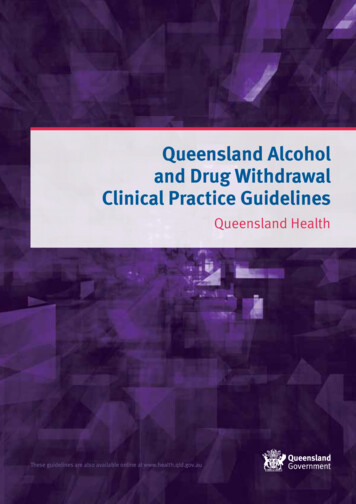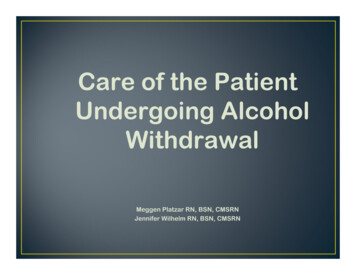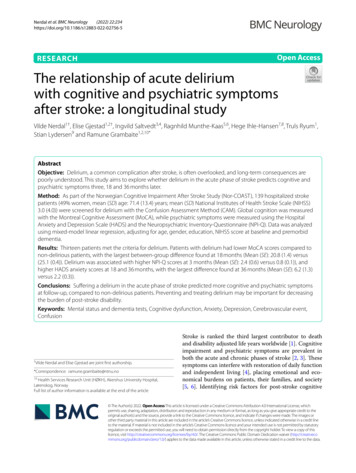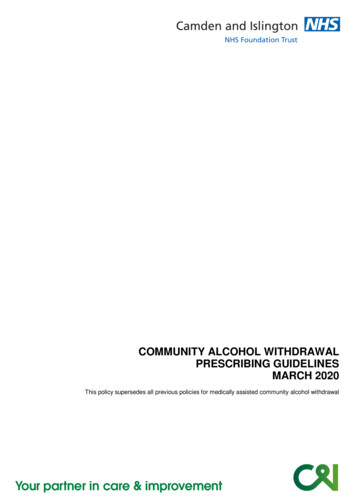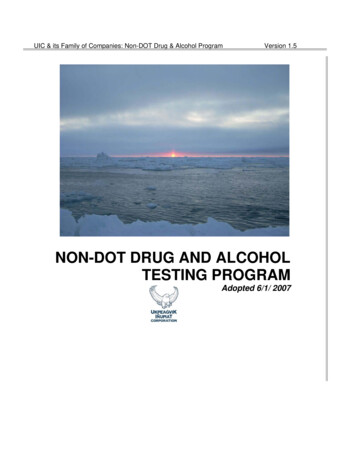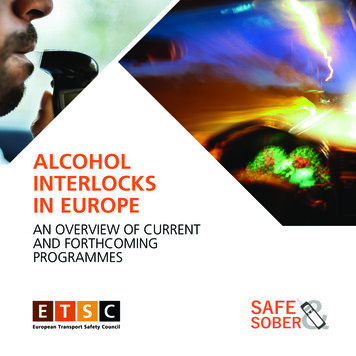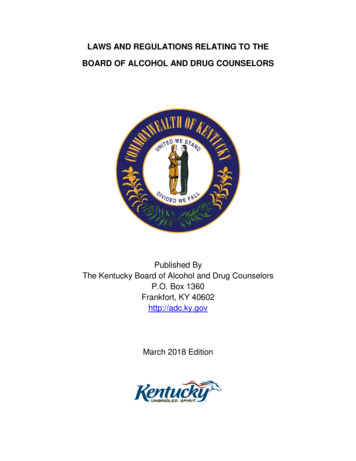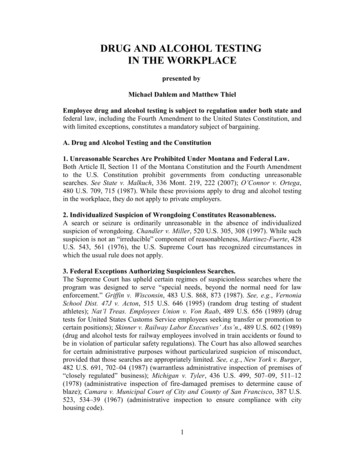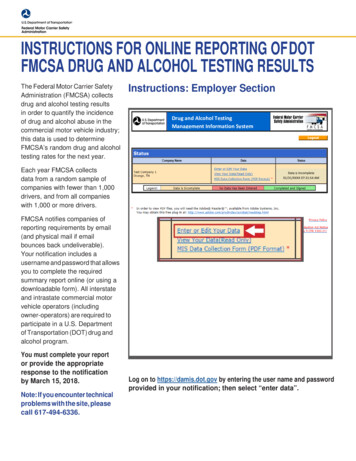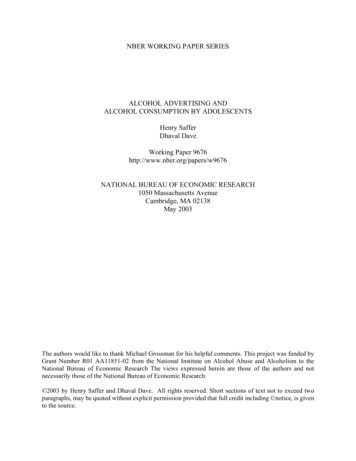
Transcription
Biomed Pap Med Fac Univ Palacky Olomouc Czech Repub. 2015 Mar; 159(1):44-52.Alcohol withdrawal delirium - diagnosis, course and treatmentBarbora Mainerovaa, Jan Praskoa, Klara Latalovaa, Karel Axmannb, Monika Cernaa, Rostislav Horacekc, Romana BradacovaaObjective. Delirium tremens represents the most severe complication of alcohol withdrawal syndrome and, in itscomplications, significantly increases the morbidity and mortality of patients. Alcohol withdrawal delirium is characterized by features of alcohol withdrawal itself (tremor, sweating, hypertension, tachycardia etc.) together with generaldelirious symptoms such as clouded consciousness, disorientation, disturbed circadian rhythms, thought processeand sensory disturbances, all of them fluctuating in time. The treatment combines a supportive and symptomaticapproach. Benzodiazepines in supramaximal doses are usually used as drugs of choice but in some countries such asthe Czech Republic or Germany, clomethiazole is frequently used as well.Method. A computer search of the all the literature published between 1966 and December 2012 was accomplishedon MEDLINE and Web of Science with the key words “delirium tremens”, “alcohol withdrawal”, “treatment” and “pharmacotherapy”. There were no language or time limits applied.Conclusions. When not early recognized and treated adequately, delirium tremens may result in death due to malignant arrhythmia, respiratory arrest, sepsis, severe electrolyte disturbance or prolonged seizures and subsequenttrauma. Owing to these possible fatalities and other severe unexpected complications, delirium tremens should bemanaged at an ICU or wards ensuring vital signs monitoring. In symptomatic treatment, high doses of benzodiazepines,especially lorazepam, diazepam and oxazepam are considered the gold standard drugs. Supportive therapy is also ofgreat importance.Key words: delirium tremens, alcohol withdrawal, treatment, pharmacotherapy, benzodiazepinesReceived: February 21, 2013; Accepted with revision: November 21, 2013; Available online: December 11, nt of Psychiatry, Faculty of Medicine and Dentistry, Palacky University Olomouc and University Hospital Olomouc, Czech RepublicDepartment of Anesthesiology and Intensive Care Medicine, University Hospital OlomouccDepartment of Intensive Surgical Care, University Hospital OlomoucCorresponding author: Jan Prasko, e-mail: praskojan@seznam.czbINTRODUCTIONlirium tremens”, “alcohol withdrawal”, “treatment” and“pharmacotherapy”. There were no language or time limits applied. The obtained list of references to the articleswas manually re-examined to find additional articles.Due to historical and social factors, alcohol doesnot usually belong to the group of illicit substances. Thisfact makes it one of the most common drugs of abusewith enormous social and economic impacts worldwide.Alcohol plays a main role in substance use disorders andalcohol abuse represents a significant issue with increasing morbidity and mortality in the population1-6.Among these complications, acute withdrawal syndrome, or withdrawal delirium, may occur when bloodor tissue alcohol levels decline after intake reduction ora modest period of cessation or dose reduction. Alcoholwithdrawal delirium always represents one of the psychiatric emergencies. The symptoms of alcohol withdrawaldelirium were first described by Samuel Pearson in 1813as a “brain fever”. The term “delirium tremens” was introduced the same year by British physician Thomas Suttonin his book “Tracts on delirium tremens, on peritonitis,and on some other inflammatory affections, and on gout”.CLINICAL PICTUREAlcohol withdrawal syndrome appears after a significant reduction or complete discontinuation of alcoholconsumption in patients suffering from alcohol dependence. The most severe complication of alcohol withdrawal syndrome is alcohol withdrawal delirium (deliriumtremens), which may be preceded or complicated by seizures. The withdrawal symptoms are caused by specificchanges in brain neurophysiology after various periods of(usually heavy) drinking7. Alcohol withdrawal syndromerepresents a group of certain symptoms that arise usually1-3 days after the last drink8. Sometimes the symptomsare already present when the alcohol blood level is above0 (0.5‰ or even more). In the mild form of the syndrome,tremor, hyperactivity, anxiety, tachycardia, sweating andsleep disturbances are present. In severe alcohol withdrawal, especially when untreated, hallucinations, seizuresand delirium may occur. Even with the proper treatment,delirium tremens may be a life-threatening condition in1-5% of patients9-12.METHODA computer search of the all the literature publishedbetween 1966 and December 2012 was accomplished onMEDLINE and Web of Science with the key words “de44
Biomed Pap Med Fac Univ Palacky Olomouc Czech Repub. 2015 Mar; 159(1):44-52.Delirium is a global confusional state (in some countries, the term “qualitative disturbance of consciousness”is used). It may present as a hyperactive state with increased arousal and psychomotor activity or agitation withsubstantial vegetative and other psychological symptoms(disorientation, illusions, hallucinations, delusions, affective instability, irritability, attention disturbance, combativeness), typical for alcohol withdrawal delirium asdescribed in ICD-10 criteria. In some patients, deliriummanifests as a hypoactive state with decreased arousaland psychomotor activity. Although this picture is rare inalcohol withdrawal delirium, it is associated with worseprognosis, delayed diagnosis and treatment and latercomplications. In the remaining patients, a mixed type ofdelirium with fluctuations between the two types is present. Complete or fragmentary amnesia is also among thedelirium symptoms.Somatic symptoms are important components of delirium. They are present at two levels: vegetative, comprising tachycardia, blood pressure fluctuations, bodytemperature increase, sweating, mydriasis, hyperhydrosis,nausea, vomiting and diarrhea and accompanying CNSsymptoms, comprising tremor, ataxia, dysarthria, dysphagia, agnosia, aphasia, myoclonus and epileptic paroxysms(usually generalized tonic-clonic convulsions).Apart from DT, here are other psychiatric problemsassociated with withdrawal such as acute alcohol halucinosis.4)5)6)7)8)9)tachycardia or hypertension;psychomotor hyperactivity;headache;insomnia;malaise or weakness;transitory visual, auditory or tactile hallucinationsor illusions;10) seizures – generalized, tonic-clonic.Delirium other than induced by alcohol or other psychoactive substances (F05.-)A. Clouding of consciousness, i.e. reduced clarity ofawareness of the environment, with reduced ability tofocus, sustain or shift attention.B. Disturbance of cognition, manifest by both:(1) impairment of immediate recall and recent memory, with relatively intact remote memory;(2) disorientation in time, place or person.C. At least one of the following psychomotor disturbances:(1) rapid, unpredictable shifts from hypo-activity tohyper-activity;(2) increased reaction time;(3) increased or decreased flow of speech;(4) enhanced startle reaction.D. Disturbance of sleep or the sleep-wake cycle, manifestby at least one of the following:(1) insomnia, which in severe cases may involve totalsleep loss, with or without daytime drowsiness,or reversal of the sleep-wake cycle;(2) nocturnal worsening of symptoms;(3) disturbing dreams and nightmares which maycontinue as hallucinations or illusions after awakening.E. Rapid onset and fluctuations of the symptoms overthe course of the day.DIAGNOSISContemporary diagnostic criteria for alcohol withdrawal delirium cover qualitative disturbance of consciousness, cognitive dysfunction fluctuating in time orrapidly developing perceptual disturbances. All the symptoms must emerge during, or shortly after, heavy alcoholintake cessation.According to the ICD-10, alcohol withdrawal delirium(F10.4) is defined as alcohol withdrawal state (F10.3)complicated by delirium (F05.-); seizures may also appear.PREVALENCEApproximately 16-26% of hospitalized patients haveproblems with alcohol dependence6. Withdrawal symptoms arise in 31% of trauma patients and in 16% of surgerypatients in the postoperative period13-15.At psychiatric wards in Germany, the annual prevalence of the diagnosis of delirium in alcohol-dependentpatients was 0.6-0.7% or 4.9-7.4 (ref.16,17). At departmentsspecializing in alcohol dependence treatment, the rate ofdelirium tremens was 5-11% (ref.18,19).In the Finnish population, the lifetime prevalence ofalcohol-induced delirium was 0.18% (95% CI 0.11-0.32%)(ref.20). Other reviews showed the expectation of experiencing withdrawal delirium to be 4-15% for alcoholdependent individuals21,22.Delirium develops in 5-20% of patients treated for alcohol withdrawal syndrome10,11,23,24, with the rates varyingfrom study to study from 1.25% to 33%.1X.3 - Withdrawal state, general criteriaG1. Clear evidence of recent cessation or reduction ofsubstance use after repeated and usually prolonged and/or high-dose use of that substance.G2. Symptoms and signs compatible with the knownfeatures of a withdrawal state from the particular substance or substances.G3. Not accounted for by a medical disorder unrelatedto substance use and not better accounted for by anothermental or behavioral disorder.Alcohol withdrawal syndrome (F10.3)A. The general withdrawal criteria must be met.B. At least 3 of the following:1) tremor of the tongue, eyelids or outstretched arms;2) sweating;3) nausea, retching or vomiting;45
Biomed Pap Med Fac Univ Palacky Olomouc Czech Repub. 2015 Mar; 159(1):44-52.ETIOPATHOGENESISDelirium tremens usually develops in individuals witha history of long-term and heavy drinking19,20.The etiopathogenesis of alcohol withdrawal deliriumwill be mentioned briefly in this paper. Although deliriumtremens is known to complicate an alcohol withdrawalstate, there is no clear explanation of the fact that only5-10% of withdrawals result in delirium25. The kindling effect is considered to play an important role in delirium development26-28. According to Ballenger and Post29, kindlingis responsible for certain graduation of withdrawal symptoms as a function of number of previous abstinence andintoxication episodes, resulting in lower seizure thresholdand CNS excitability. This represents a stimulus for thekindling process in subcortical structures (the limbic system, hypothalamus and thalamus). The more often withdrawal episodes repeat, the more severe they become andmay result in seizures and delirium tremens.Chronic exposure to ethanol results in down-regulationof inhibitory gamma-aminobutyric acid (GABA) receptorsin the CNS. On the other hand, excitatory N-methyl-Daspartate (NMDA) glutamate receptors are up-regulatedin alcohol dependence. Abrupt cessation of alcohol intakeresults in withdrawal syndrome when this neuroadaptation is unmasked31. The role of benzodiazepines in alcoholdetoxification is to re-establish the balance and suppressthe predominance of glutamate by enhancing GABAtransmission. In the United States, benzodiazepines arerecommended in moderate to severe alcohol withdrawaland delirium tremens management11.The neurophysiology of GABA and glutamate transmission is identical in alcohol withdrawal delirium. Anincrease in noradrenaline and dopamine neurotransmission was discovered as well. Neurotoxicity, damage ofCNS neurons, arousal and sympathetic activity increaseresulting from oxidative stress and increased intracellularcalcium influx represent common findings in deliriumtremens. Benzodiazepine and clomethiazole use is also inaccordance with the GABA-ergic model and has a positiveinfluence on withdrawal and epileptic seizures.COURSEDelirium usually develops within 24-72 h as an acuteor subacute complication of withdrawal syndrome32-37.Throughout the day, the fluctuation of symptoms istypical with worsening in the evening and at night (disturbance of circadian rhythm or its inversion). The symptomsusually slowly subside within 1-7 days. The symptoms ofwithdrawal itself (as defined in the ICD-10) are often stillpresent several days after the delirious features have fullysubsided.Despite complete or partial amnesia, the experienceof delirium is traumatizing for the patient and may lead tolong-term mental disorders interfering with full recovery.COMPLICATIONS OF DELIRIUM TREMENSDelirious patients have high morbidity and mortalityrates. Mortality in the next 8 years after an episode of delirium tremens was 30.8% (HR 1.38, 95% CI 0.43-4.48),which is comparable with patients suffering from severemalignant diseases20,38.Without proper management, mortality may rangefrom 5% to 15% or even 20% (ref.23,39). When treated appropriately (benzodiazepines) and detected early, themortality should not exceed 1% (ref.11,40).Delirium tremens may be complicated by several severe or life-threatening conditions. When diagnosed andmanaged insufficiently, the morbidity and mortality ratesincrease, hospitalization prolongs and complications suchas status epilepticus, coma or other severe psychiatricdisorders such as Wernicke-Korsakoff syndrome, centralpontine myelinolysis, chronic alcohol halucinosis or evendementia may develop.As the most frequent complications, injuries (bed falls,seizures) such as fractures, intracranial hemorrhage, hypokalemia, hypomagnesemia, upper gastrointestinal bleeding, pneumonia, vomiting, aspiration with pneumonia,respiratory arrest, arrhythmias, sepsis, bed sores or deathmay emerge; also possible escape from the ward may result in an injury or unintentional self-injury32,33,36.Alcohol withdrawal phasesSHAKESTREMORS1 BLOWN DTPANIC1721TREATMENT23The management of delirium tremens represents amultidisciplinary (psychiatry, neurology, intensive andinternal medicine professionals etc.) and comprehensiveapproach, with nurses and the patient’s family being involved as well. The treatment is provided at six differentlevels41.25Number of alcohol withdrawal episodes esƟmaƟonPreventive measuresAccording to clinical experience, thorough monitoring and prompt treatment of the withdrawal syndrome isFig. 1. The kindling phenomenon, adapted from Post 2002(ref.30).46
Biomed Pap Med Fac Univ Palacky Olomouc Czech Repub. 2015 Mar; 159(1):44-52.the best way of preventing severe complication such asdelirium tremens42.Many studies focus on severe alcohol withdrawal syndrome from the point of view of possible risk factors.A previous episode of delirium and/or seizures duringwithdrawal in the patient’s history seems to be the greatest risk factor/ predictor10,23,24,43,44. Other risk factors/predictors may be concurrent medical illness or infectiousdiseases10,19,40,43,45. According to other studies, tachycardiaof more than 100 or 120 beats per minute and hypertension – systolic blood pressure over 145 mmHg - above mayrepresent potential risk factors/predictors23,43,44.There are several laboratory features showing a potential risk of delirium such as low levels of serum potassiumalthough this finding could not be replicated in a studyusing subsequent multivariate analysis23,46,47. Accordingto studies using specially designed rating scales, elevatedliver enzymes - alanine aminotransferase (ALT), aspartateaminotransferase (AST) and gamma-glutamyltransferase(GGT) - or carbohydrate-deficient transferrin (CDT) andmean corpuscular volume (MCV) can predict more severealcohol withdrawal48. Brathen et al. described significantrelation of elevated levels of ALT, AST, ALT/AST ratio,GGT and CDT and alcohol-related seizures, with CDTbeing the best single marker. Low sensitivity of all theselaboratory parameters impede their routine clinical use inpredicting severe withdrawal48,49.A study of 182 alcohol-dependent individuals showedsignificant association of early emergency managementand serum ALT level above 1.5-fold the upper limit andsevere withdrawal symptoms21. In other studies, the frequency of thrombocytopenia or functional changes ofplatelets was much higher in patients developing deliriumor seizures12,50. Some studies show some connection between brain serotonin dysregulation due to monoaminooxidase (MAO) inhibion and DT development in alcoholdependent individuals50,51. Changes in liver enzymes andCDT in delirious patients may, as parallel phenomena,show excessive alcohol intake. Also plasma levels of themethionine metabolite homocysteine are significantly elevated in individuals with delirium tremens as comparedto uncomplicated withdrawal. Homocysteine elevationwas found to be connected with withdrawal seizure acitivity52,53.In case of a high risk of alcohol withdrawal delirium,the use of benzodiazepines for preventive purposes maybe reasonable.There is no evidence that administration of ethanolto delirious patients or those at risk for delirium is superior or even equal in effect or side effects to benzodiazepines54,55.Patients fearing the withdrawal symptoms, can loseadherence to the treatment of their dependence when thewithdrawal symptom control and management are not adequate at the very beginning9,56,57. A proper detoxificationprogram and withdrawal management can alleviate futureseverity of subsequent attacks of the alcohol withdrawalsyndrome and help to increase the motivation for comprehensive treatment and abstinence9,58. From the pharmaco-logical point of view, benzodiazepines were found to beeffective in the treatment of alcohol withdrawal, seizuresand delirium tremens prevention59-61. The existence of adirect antidote for benzodiazepines favors them as a drugof choice62.Chlordiazepoxide in a fixed dosage (FD) schedulewith gradual reduction in 8-10 days is one of the mostcommonly used drugs for alcohol withdrawal treatment8.In inpatients, some authors prefer the so-called symptomtriggered (ST) schedule to FD with a maximum loadingdose of up to 30 mg of diazepam equivalent, or a frontloading regimen comprising an initial high dose followedby ST or FD (ref.11,63-65). However, there is a suggestionthat even in outpatients, this regimen may help to motivate the patients to start their dependence treatment60,61.In a study of 165 patients, the quantity of medication, relapse time in the following 12 months, well-being or treatment satisfaction did not significantly differ in a group ofpatients treated with FD and those with an ST approach8.A recent prospective, randomized clinical trial reportedno significant difference between loading or ST regimensof benzodiazepine administration in alcohol withdrawalmanagement66. Some authors recommend ST under 24-hmedical monitoring or ICU observation54,64 .Eliminating and correcting somatic complicationsEarly supplementation with vitamins (especially B1),glucose and fluids with electrolytes (magnesium, potassium) is vital in delirium tremens32,33,67-69. When pureglucose is administered, severe cardiomyopathy orWernicke’s encephalopathy develop quickly due to theutilization of the last thiamine reserves in activated glycolysis. High doses (300-500 mg/day) of thiamine should beadministered together with or prior to glucose and shouldnot be discontinued for 7-14 days (better administeredparenterally because of reduced ability to be absorbed inan oral form) (ref.54,70,71).Caring for the overall physical conditionMany factors can significantly affect the outcome, development and course of delirium. These are especiallypatient monitoring, safety, balanced homeostasis (hydration, nutrition), vital function support, prevention of urineand fecal retention, early mobilization, stabilization ofchronic illnesses (hepataic, coagulation, anemia).Adjusting environmental conditionsEnvironmental factors can influence the overall condition and should contribute to the patient’s calming down.The general rules are as follows: quiet and caring environment, preferably a single room or adequate bed distance,no unnecessary objects, checks ups at least four times perhour with attempts to reorient the patient and minimization of outside noise. In case of extreme agitation or aggression, mechanical restrains may be applied for as shortas possible and under close monitoring to prevent harm tothe self/others32,33,67. A watchful and sensitive approach ofthe nursing personnel is absolutely important.47
Biomed Pap Med Fac Univ Palacky Olomouc Czech Repub. 2015 Mar; 159(1):44-52.Symptomatic and supportive treatmentDrug doses should be as low as possible to achieve theproper effect and tranquilization and should be distributed in intermittent boluses with focus on the rapid onsetand its adjustment to the general condition. Prematurediscontinuation of the medication may result in deliriumrelapse in the next 24 h. The whole treatment with gradualreduction of the medication usually takes 7-14 days.In symptomatic therapy, benzodiazepines are thedrugs of choice; in some regions, clomethiazole is usedas well72-78. In alcohol withdrawal delirium, supportivetherapy is essential as well.There is cross-tolerance of alcohol and medicationcommonly used in the treatment of alcohol withdrawal11.In mild or moderate symptoms of alcohol withdrawal,carbamazepine may be used as an alternative drug butits use in withdrawal delirium has not been sufficientlyproved75. Under certain conditions, other additional drugsmay be used together with benzodiazepines, for exampleantipsychotics (haloperidol, beta-blockers, clonidine orphenytoin) (ref.79). In case of refractory delirium, propofol has also been recently shown to be an effective adjunctive drug80-83.state is achieved; in benzodiazepines, approximately to15-20% of the total dose a day36.Some studies comparing clomethiazole with benzodiazepines showed its effectiveness and some of themreported shortening and generally better tolerance oftreatment as well69,86,87.BenzodiazepinesThe most frequently used drugs in delirium tremensmanagement are benzodiazepines. Usually, short-actingagents are preferred (e.g. lorazepam, midazolam and oxazepam). In clinical practice, diazepam, clonazepam orchlordiazepoxide are used as well. Oxazepam and lorazepam should be preferred as drugs of choice because oftheir advantageous pharmacokinetics and dynamics (noactive metabolites, favorable liver metabolization by conjugation/glucuronidation). Benzodiazepines (especiallyclonazepam and diazepam) are also beneficial in epileptic seizure management as epileptic activity is a frequentcomplication seen in alcohol withdrawal and withdrawaldelirium (up to 30%). They are also the drugs of choicein sedative and hypnotic withdrawal deliria.The dosage of benzodiazepines is supramaximal indelirium tremens or withdrawal state, comparing to theircommon use in anxiolytic or other indications (60-90 mgof diazepam equivalent a day) (ref.32). When administered intravenously, the risk of respiratory depression isimminent and the patient should be managed at the ICU(ref.69).Temporarily, administration of midazolam in a continuous infusion is considered to be suitable in intensivecare.Potential complications of benzodiazepine therapyrequire increased vigilance of the involved clinicians. Asshort-acting benzodiazepines such as oxazepam or lorazepam are used in ST regimens according to the severityof withdrawal symptoms, the nursing personnel and clinicians trained in intensive care are needed to recognizepotential complications (e.g. infection) or other changesin patients’ condition, which may mimic or blunt withdrawal syndrome features. Long-acting benzodiazepines(i.e. diazepam, chlordiazepoxide) are commonly administered in FD regimens88. The peril of the FD approach isseen in under- or overestimation of the total dose resulting in excessive sedation or, oppositely, loss of control ofwithdrawal symptoms. Additionally, in patients who arestill alcohol intoxicated, unpredictable interactions withbenzodiazepines (somnolence, respiratory depression orarrest and death) may emerge. That is why in such cases,continuous and careful monitoring of their condition isnecessary89.Potential risk of abuse and addiction must be takeninto consideration anytime benzodiazepines are used inwithdrawal management in outpatient settings90.Subsequent careAfter delirium subsides, there is a great need of propereducation and supportive psychotherapy for the patientsand their families consisting of gentle explanation of theunderlying causes, withdrawal and delirious phenomena or bizarre experiences. The therapist aims to get thepatient’s full understanding of delirious symptoms, toprevent shame, guilt or depreciation and to help with reintegration into their original environment. Subsequent caremay have a great influence on the patient’s motivation tocommence the long-term and complex treatment of alcohol dependence and has an impact on further adherence.ClomethiazoleThe GABA-ergic model of alcohol withdrawal andwithdrawal delirium favors benzodiazepines in the treatment. For adequate alleviation of delirious symptoms,four to six 300 mg clomethiazole capsules are administered initially and according to the current condition thedose is repeated every 2-3 h until the calming effect isachieved, with the maximum dose being 24 capsules perday. The parenteral form of clomethiazole is no longeravailable on the market because of many deaths due toinappropriate use, insufficient monitoring of patients orother fatal respiratory complications84,85. If delirious patients are managed at ICUs where continuous vital function monitoring is available, clomethiazole doses maybe increased to 7.2 g (12 g) (ref.32,33). As in benzodiazepines, CNS respiratory center depression may emergewhen clomethiazole is used. Additionally, there is a riskof pneumonia due to bronchial secretion accumulation.Since clomethiazole is potentially addictive, it should notbe administered for more than 10 days67,68. The administration of both clomethiazole and benzodiazepines mustbe short-term, with gradual dose reduction after a steadyAntipsychoticsTiapride, an atypical D2/D3 antipsychotic agent, canbe used in uncomplicated alcohol withdrawal syndrome.It is safe, with a wide therapeutic range - the doses can48
Biomed Pap Med Fac Univ Palacky Olomouc Czech Repub. 2015 Mar; 159(1):44-52.vary from 300 to 1800 mg/day - and both oral and parenteral ways of administration. The total daily dose shouldbe administered in at least 3-4 doses. It should not be usedin patients with an increased risk of epilepsy because ofits potential to lower the seizure threshold91,92.In delirium tremens, tiapride alone has not shown tobe effective enough so its use should be limited to uncomplicated withdrawal93.Antipsychotics in delirium tremens should be used asaugmentation in extremely agitated or aggressive patients,always in combination with benzodiazepines - the GABAergic agents are preferred. Haloperidol may be added tothe medication in doses of 5-15 mg a day. Since there is arisk of arrhythmia due to the QT interval prolongation together with hypokalemia and seizure threshold lowering,that the patient should be monitored at the ICU (ref.11,94).The of haloperidol increases mortality rate.of 800 mg a day in both fixed and tapered regimens. Theprobable explanations for studies failing to prove the therapeutic efficacy are delayed administration of the drug,underenrollment, low dosages and a bias in outcomeassessment. Due to inconsistent outcomes in two studies, the benefit of oxcarbazepine in alcohol withdrawalremains undefined. However, carbamazepine showed itseffect in reduction of moderate to severe withdrawal syndrome in inpatients. Benzodiazepines should remain thedrugs of first choice in severe alcohol withdrawal state.There are studies showing the efficacy of sodiumvalproate in alcohol withdrawal its use is discouraged inmore severe cases106-108.There is an open trial of gabapentin, a GABA-ergic anticonvulsant, in the treatment of acute alcohol withdrawalbut not delirium tremens itself, showing its effectivenessin reducing mild symptoms109.Despite the fact that other antiepileptic drugs such astopiramate and lamotrigine110-112 may be successfully usedin alcohol withdrawal management, there is not enoughreliable evidence for their use in alcohol withdrawal delirium.AntiepilepticsThe anticonvulsants of non-benzodiazepine type carbamazepine and oxcarbazepine with likely GABA-ergicand NMDA-blocking activity represent other drugs of possible use87,95,96. Carbamazepine has been used for over 30years to treat alcohol withdrawal as a non-addictive, nonsedating agent reducing alcohol withdrawal symptoms52,87.The newer anticonvulsant oxcarbazepine, a structurallymodified carbamazepine, does not carry carbamazepine’sside-effects of active metabolites.A number of studies have confirmed carbamazepineefficacy in reducing symptoms of alcohol withdrawalsyndrome in the inpatient setting72,97-102. Compared withbenzodiazepines or clomethiazole, carbamazepine wasfound effective in alcohol detoxification in seven randomized controlled studies72,90,97-101. The focus was mainly onalcohol withdrawal features, delirium and seizures occurrence or presence of two or all three of them together.Six of those studies demonstrated significant alleviationin clinician-rated withdrawal phenomena using fixed ortapered (over 5-9 days) regimen with 800 mg daily as aninitial dose.In four out of seven randomized controlled studiescomparing the efficacy of carbamazepine and benzodiazepines in alcohol withdrawal, the frequency of seizuresand delirium tremens was reported with the odds ratio fordelirium [OR 1.25 (95% CI 0.28-5.64), P NS] andseizures [OR 0.93 (93% CI 0.06-14.97), P NS], thusshowing no significant difference.On the other hand, there are four randomizedcontrolled trials of alcohol withdrawal managementshowing no effect of either oxcarbazepine or carbamazepine72,101,103,104.According to inpatient trials of clinician-rated sympt
Biomed Pap Med Fac Univ Palacky Olomouc Czech Repub. 2015 Mar; 159(1):44-52. 44 Alcohol withdrawal delirium - diagnosis, course and treatment Barbora Mainerovaa, Jan Praskoa, Klara Latalovaa, Karel Axmannb, Monika Cernaa, Rostislav Horacekc, Romana Bradacovaa Objective.
